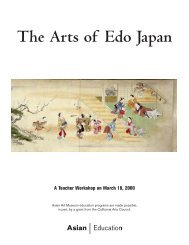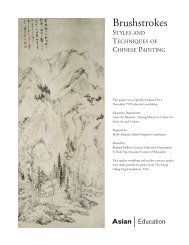Sacred Arts of Tibet (.pdf) - Asian Art Museum | Education
Sacred Arts of Tibet (.pdf) - Asian Art Museum | Education
Sacred Arts of Tibet (.pdf) - Asian Art Museum | Education
You also want an ePaper? Increase the reach of your titles
YUMPU automatically turns print PDFs into web optimized ePapers that Google loves.
<strong>Sacred</strong> <strong><strong>Art</strong>s</strong> <strong>of</strong> <strong>Tibet</strong><br />
Rinpoche, is a patriarch <strong>of</strong> the Nyingmapa lineage (one <strong>of</strong> the four Buddhist lineages <strong>of</strong> <strong>Tibet</strong>).<br />
Establishment <strong>of</strong> the First Buddhist Monastery in <strong>Tibet</strong><br />
<strong>Tibet</strong>’s first monastery, Samye, was founded in 779 under the guidance <strong>of</strong> Padmasambhava, and the first<br />
<strong>Tibet</strong>an monks were ordained. This marks the establishment <strong>of</strong> monasticism, the basis for all Buddhist<br />
societies, in <strong>Tibet</strong>. To <strong>Tibet</strong>ans it is more than their oldest monastery, Samye symbolizes the root <strong>of</strong> their<br />
Buddhist heritage. The monastery grounds were designed as a mandala, a physical representation <strong>of</strong> pure<br />
nature <strong>of</strong> the universe (see Slide 4). Samye became an important center <strong>of</strong> translation <strong>of</strong> texts, religious<br />
practice, and art. Many great teachers and artisans came from India, Nepal, Kashmir, and Central Asia to<br />
work here. In 791 Buddhism was declared the <strong>of</strong>ficial religion <strong>of</strong> <strong>Tibet</strong>.<br />
In 836 a reactionary king, named Lang Darma, seized the throne with the support <strong>of</strong> conservative nobles<br />
and Bön priests. He set out to extinguish Buddhism in <strong>Tibet</strong>, destroying monasteries and persecuting<br />
monks. Although he was successful in Lhasa, Buddhist practice continued in the other regions <strong>of</strong> <strong>Tibet</strong>.<br />
He was finally assassinated in 842, marking the end <strong>of</strong> any effective opposition to Buddhism in <strong>Tibet</strong>.<br />
After his death the court fell to internal power struggles, which, coupled with a series <strong>of</strong> military setbacks<br />
on the frontiers, broke <strong>Tibet</strong> into regional territories held by local kings. For the next two centuries,<br />
<strong>Tibet</strong>an history falls into a fragmented political state until the next great religious awakening.<br />
14<br />
<strong>Asian</strong> <strong>Art</strong> <strong>Museum</strong>
















